Archive for the ‘Artists’ Category
The History of Poster Art over the last two Centuries. Part 5
Today we are continuing with our ongoing exploration of the History of Poster Art as it evolved over the last two centuries.
In Parts 1-4 of this Blog we commented on the early history of the poster since the late 1800’s. French artists that worked during the “Belle Epoque” deserve credit for developing this new art form, in particular the works of “the father of the poster”, Jules Chéret and his publication “Maitres de l’Affiche”.
We also introduced a number of important artists of the era and their creations, Mucha, Toulouse-Lautrec, Cappiello, Grasset, Steinlen and Rhead. Today we “follow” Rhead to the US where poster art was still in infancy.
Louis John Rhead (1857–1926)
Louis John Rhead was an English-born American artist who emigrated to the United States at the age of twenty-four and had great influence on American poster designers.
In the United States, posters had not evolved to the same artistic level as in Europe. American posters were primarily directed towards basic commercial needs to deliver a written message.
However, the new influences from Europe and the advent of the travelling circus brought colorful posters to tell citizens that a carnival was coming to town.

Ringling Bros. and Barnum & Bailey, ca. 1900
But many of these too were very commercially utilitarian, of average quality, and only a few saw any real artistic creativity.

Al G. Barnes Circus, ca. 1900’s
This changed in the 1920’s and 1930’s when many posters appeared that had great artistic merit and have become extremely collectible. These include the posters advertising World’s Fairs and Colonial Exhibitions.

Travel posters
With the advent of the industrial revolution, travel by train, plane and bus gave rise to tourism and posters promoting travel destinations. Tourist Offices, airlines, railroad and bus companies commissioned artists to promote their business.
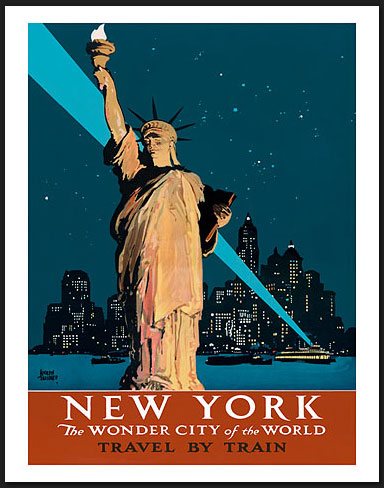
In the next few Blogs we will introduce some highlights of Travel & Tourism posters that were designed by talented artists. This new art form was popular until the 1960’s when photography took the place of graphic art.
 Pan American World Airways, commonly known as Pan Am was the principal and largest international air carrier in the United States from 1927 until its collapse on December 4, 1991. Founded in 1927 as a scheduled air mail and passenger service operating between Key West, Florida, and Havana, Cuba, the airline became a major company credited with many innovations that shaped the international airline industry.
Pan American World Airways, commonly known as Pan Am was the principal and largest international air carrier in the United States from 1927 until its collapse on December 4, 1991. Founded in 1927 as a scheduled air mail and passenger service operating between Key West, Florida, and Havana, Cuba, the airline became a major company credited with many innovations that shaped the international airline industry.
Identified by its blue globe logo, the use of the word “Clipper” in aircraft names and call signs, and the white pilot uniform caps, the airline was a cultural icon of the 20th century. In an era dominated by flag carriers that were wholly or majority government-owned, it was also the unofficial flag carrier of the United States.
Pan Am was one of the first airline companies to use posters in promoting the travel destinations the carrier serviced. During the early era of tourism also dubbed “The Golden Age of Travel” Pan Am commissioned such artists as Paul George Lawler, Mark von Arenburg, Ivar Gull and others to design posters for the routes of the famous Clipper Ships.
These posters are now highly collectible and are being auctioned by Christie’s, Swann Galleries and other such establishments and fetch high prices.

Fly to South Sea Isles, Paul George Lawler, ca. 1940’s

Fly to Europe by Clipper, Mark von Arenburg, ca. 1940’s

Norway, Land of the Midnight Sun; Ivor Gull, ca. 1930’s
To be continued… to view further works by these poster artists, please visit our web sites: classicvintageposters.com and islandartstore.com. Thank you for your interest in these blogs, your feedback is appreciated.
Bernard Lassalle bernard@classicvintageposters.com
The History of Poster Art over the last two Centuries. Part 4
Today we are continuing with our ongoing exploration on the History of Poster Art and the development of this art form over the last two centuries.
In Part 3 of this Blog I introduced Alphonse Mucha, Eugene Grasset and Théophile Steinlen who were featured in “Maitres de l’Affiche”- a publication that appeared from December 1895 to 1900 and was published by Jules Chéret- the “father of the modern poster” (see Blog #2 in this series for more info).
Next I want to focus on some of the other artists that were featured in “Maitres de l’Affiche” and in another publication called “L’Estampe Moderne”.
Leonetto Cappiello, Henri Meunier, and many others became important figures of their day, their art form transferred to magazines for advertising as well as for social and political commentary.
Leonetto Cappiello (1875–1942)
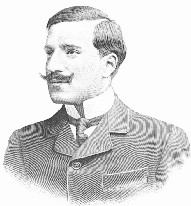 Leonetto Cappiello (9. April 1875 in Livorno, Italy – 2. February 1942 in Cannes, France) was an Italian poster art designer who lived in Paris. He is now often called ‘the father of modern advertising’ because of his innovation in poster design. The early advertising poster was characterized by a painterly quality as evidenced by early poster artists Jules Chéret, Alfred Choubrac and Hugo D’Alesi. Cappiello, like other young artists, worked in way that was almost the opposite of his predecessors. He was the first poster artist to use bold figures popping out of black backgrounds, a startling contrast to the posters early norm.
Leonetto Cappiello (9. April 1875 in Livorno, Italy – 2. February 1942 in Cannes, France) was an Italian poster art designer who lived in Paris. He is now often called ‘the father of modern advertising’ because of his innovation in poster design. The early advertising poster was characterized by a painterly quality as evidenced by early poster artists Jules Chéret, Alfred Choubrac and Hugo D’Alesi. Cappiello, like other young artists, worked in way that was almost the opposite of his predecessors. He was the first poster artist to use bold figures popping out of black backgrounds, a startling contrast to the posters early norm.
Cappiello had no formal training in art. The first exhibition of his work was in 1892, when a painting was displayed at the municipal museum in Florence.
Cappiello moved to Paris in 1898 and started his career as a caricaturist illustrating in journals like Le Rire, Le Cri de Paris, Le Sourire, L’Assiette au Beurre, La Baionnette, Femina, and others. Later Cappiello began to move away from caricature work favoring posters. Cappiello made his name during the poster boom period in the early 20th century, with designs markedly different from premier poster artist Jules Chéret.
Cappiello’s career as a poster artist began in earnest in 1900 when he began a contract with the printer Pierre Vercasson. During this period, the printers would act as an agent for artists and commission work to them. Vercasson had a print house, and his goal was to bring color to the streets of Paris, he wanted the posters that he produced to stand out from the rest and attract lucrative new advertisers to his agency. Of course living in Paris, he was aware of the current art scene, and had seen many examples of Cappiello’s work, including a small number of posters already produced and in particular those for Le Frou-Frou.

Leonetto Cappiello; CARNAVAL, “Vinho do Porto”
He knew that Cappiello had the potential to be exactly what he was looking for. The relationship commenced with the arrangement that Vercasson would find the clients and brief Cappiello on the product. It was then up to Cappiello to produce a sketch for the client for which he would receive the fee of 500 francs, a good amount at the time. Once the design had been approved by the client a full size design would be produced for the poster at a size of 1×1.4m, an old French paper standard known as the Double Grand Aigle. Cappiello would also be responsible for ensuring the successful transfer of the design onto lithographic stone ready for printing.
In 1918 Capiello signed an exclusive contract with the Paris publisher Devambez for whom he designed now famous icons: such as Kub, Campari, Parapluie Revel, Pirelli, Chocolat Klaus and Poudre de Luzy, and the famous entertainer Mistinguette at the Casino de Paris.
Over the course of his career Cappiello produced more than 530 advertising posters.Today, his original posters are still sold at auction and sought after by dealers and collectors around the world.

Leonetto Cappiello; “Pates Baroni”
Henri Meunier (1873-1922)
He was a Belgian Art Nouveau lithographer, etcher, illustrator, bookbinder and poster designer of the Belle Époque.

Henri Meunier, “Rajah Coffee”
After studying at the academy in Ixelles, he diversified into printmaker, poster designer, graphic reporter and book binder. Meunier used flat colours and thick outlines, borrowed from Japanese prints, to achieve powerful images.

Henri Meunier, “Savon Starlight”
Many of his lithographs were published in L’Estampe Moderne, which appeared from 1897-98 as a series of 24 monthly portfolios, each of 4 original lithographs, priced at 3 francs 50 centimes and printed by F. Champenois of Paris.
Contributing artists included Louis John Rhead, Théophile Alexandre Steinlen, and Eugène Grasset.
We already introduced Steinlen and Grasset in previous blogs, here then some biographical notes and examples of Louis John Rhead’s work, an artist who brought the poster art of the “Belle Epoque” from Europe to the US.
Louis John Rhead (November 6, 1857 – July 29, 1926)
was an English-born American artist, illustrator, author and angler who was born in Etruria, Staffordshire, England. He emigrated to the United States at the age of twenty-four.
The Rhead family had operated and worked in the Staffordshire Potteries for at least three generations. Louis’s father George W. Rhead worked in the pottery industry and was highly respected gilder andceramic artist. In the 1870s, George Rhead taught art and design in Staffordshire schools. He founded Fenton School of Art.
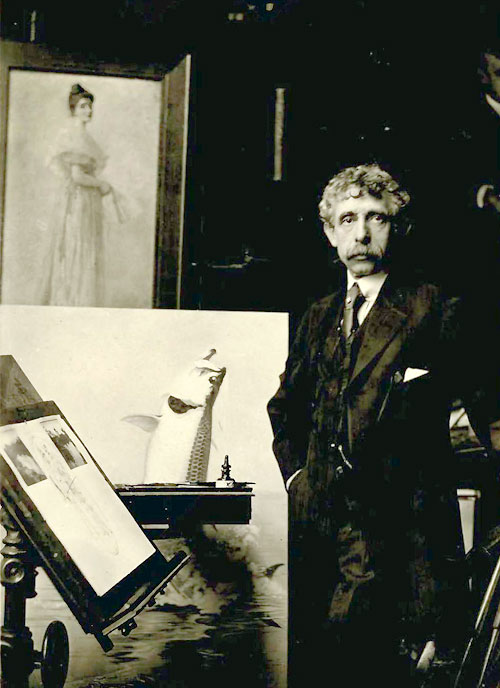
Louis John Rhead in his studio circa 1920
Louis and all his siblings attended their father’s art classes and worked in the potteries as children. Because Louis demonstrated exceptional talent, when he was thirteen in 1872, his father sent him to study in Paris, France with artist Gustave Boulanger. After three years in Paris, Louis Rhead returned to work in the potteries as a ceramic artist at Minton and later at Wedgwood.
In 1883 at the age of twenty-four, Louis Rhead was offered a position as Art Director for the U.S. publishing firm of D. Appleton in New York City. He accepted and emigrated to the U.S. in the fall of 1883. In 1884 he married Catherine Bogart Yates, thus becoming an American citizen. Louis and Catherine lived in Flatbush overlooking Prospect Park for forty years.
In the early 1890s, Rhead became a prominent poster artist and was heavily influenced by the work of Swiss artist Eugène Grasset. During the poster craze of the early 1890s, Rhead’s poster art appeared regularly in Harper’s Bazaar, Harper’s Magazine, St. Nicolas, Century Magazine, Ladies Home Journal and Scribner’s Magazine. In 1895 he won a Gold Medal for Best American Poster Design at the first International Poster Show in Boston.

Louis John Rhead, Read the Sun, 1900
Between 1902 and his death in 1926, Rhead illustrated numerous children’s books published by Harpers and others. Most notable among these were editions of: Robin Hood, The Swiss Family Robinson, Robinson Crusoe, The Deerslayer, Treasure Island, Kidnapped and Heidi.
Rhead was an avid fly fisher and by his own account started fishing for trout in the U.S. sometime between 1888 and 1890.
Louis Rhead’s death was somewhat unusual. He died from a heart attack at his retirement home in Amityville, Long Island. A portion of his obituary in The New York Times, Friday July 30, 1926:
“LOUIS RHEAD, ARTIST AND ANGLER, DEAD. Exhausted Recently by Long Struggle In Capturing a 30-pound Turtle.
…About two weeks ago Mr. Rhead set out to catch a turtle weighing thirty pounds which had been devastating trout ponds on his place, Seven Oaks. After the turtle was hooked, it put up a fight for more than half an hour. Although Mr. Rhead was successful in the end, he became exhausted. A short time later he suffered from his first attack of heart disease. Yesterday’s was his second.”
To be continued… to view further works by these poster artists, please visit our web sites: classicvintageposters.com and islandartstore.com. Thank you for your interest in these blogs, your feedback is appreciated.
Bernard Lassalle
bernard@classicvintageposters.com
The History of Poster Art over the last two Centuries. Part 3
…..continued from our ongoing exploration on the History of Poster Art over the last two centuries. In Part 2 of this Blog I introduced Jules Chéret, “the father of the modern poster” and his publication “Maitres de l’Affiche”. Next I want to focus on some of the artists that were featured in this publication that promoted the poster as an independent art form.
Alphonse Mucha, Eugène Grasset and Théophile Steinlen were influential poster designers of this generation, known for their Art Nouveau style and stylized figures, particularly of women. Advertisement posters became a special type of graphic art in the modern age. These three artists, along with many others, were part of a circle of artists whose art form transferred to magazines for advertising as well as for social and political commentary.
Alphonse Mucha (1860-1939)
 Alphonse Mucha was a Moravian (Czechoslovakia) painter of the late 19th and early 20th centuries. He started his career working at decorative painting jobs in Moravia, mostly designing theatrical scenery. His employer was very much inspired by his work and sponsored Mucha’s formal training at the Munich Academy of Fine Arts. Afterwards Mucha went to Paris for further studies. Mucha has a significant role in the Art Nouveau movement and created pieces that have achieved classic status. He was the creator of numerous paintings, illustrations, advertisements, postcards and designs which became an inspiration for many artists of his time. He invested many years of his life creating his fine art masterpiece, The Slav Epic. It contained twenty huge paintings that illustrated the history of the Czech and the Slavic people which was donated to the city of Prague in 1928.
Alphonse Mucha was a Moravian (Czechoslovakia) painter of the late 19th and early 20th centuries. He started his career working at decorative painting jobs in Moravia, mostly designing theatrical scenery. His employer was very much inspired by his work and sponsored Mucha’s formal training at the Munich Academy of Fine Arts. Afterwards Mucha went to Paris for further studies. Mucha has a significant role in the Art Nouveau movement and created pieces that have achieved classic status. He was the creator of numerous paintings, illustrations, advertisements, postcards and designs which became an inspiration for many artists of his time. He invested many years of his life creating his fine art masterpiece, The Slav Epic. It contained twenty huge paintings that illustrated the history of the Czech and the Slavic people which was donated to the city of Prague in 1928.
Though Mucha’s works were stamped outdated after his death, his works have now become something to look for inspiration for the illustrators and artists today.

Alphonse Mucha; JOB Cigarette Rolling Paper, Monaco- Monte- Carlo
Eugène Samuel Grasset (1845–1917)
 Eugène Samuel Grasset was a Swiss decorative artist who worked in Paris, France in a variety of creative design fields during the Belle Époque. He is considered a pioneer in Art Nouveau design.
Eugène Samuel Grasset was a Swiss decorative artist who worked in Paris, France in a variety of creative design fields during the Belle Époque. He is considered a pioneer in Art Nouveau design.
He studied drawing and in 1861 went to Zurich to study architecture. After completing his education, he visited Egypt, an experience that would later be reflected in a number of his poster designs. He became an admirer of Japanese art, which influenced some of his designs.
In 1877 Eugène Grasset turned to graphic design, producing income-generating products such as postcards and eventually postage stamps for both France and Switzerland. However, it was poster art that quickly became his forte. Some of his works became part of the “Les Maîtres de l’Affiche” publication including his lithograph, “Jeanne d’Arc Sarah Bernhardt.”
With the growing popularity of French posters in the United States, Grasset was soon contacted by several American companies. In the 1880s, he did his first American commission and more success led to cover designs for Harper’s Magazine. Grasset’s work for U.S. institutions helped pave the way for Art Nouveau to dominate American art.
At the Universal Exhibition of 1900 in Paris, the G. Peignot et Fils typefoundry, introduced the “Grasset” typeface, an Italic design Eugène Grasset created in 1898 for use on some of his posters.

Eugene Grasset (Salon des Cent).
Théophile Alexandre Steinlen (1859 – 1923)
Théophile Alexandre Steinlen was a Swiss-born French Art Nouveau painter and printmaker.
In his early twenties he was still developing his skills as a painter when he and his new wife moved to the artistic community in the Montmartre Quarter of Paris. Montmartre and its environs, was a favorite subject throughout Steinlen’s life and he often painted scenes of some of the harsher aspects of life in the area. In addition to paintings and drawings, he also did sculpture on a limited basis, most notably figures of cats that he had great affection for as seen in many of his paintings.
Steinlen became a regular contributor to Le Rire and Gil Blas magazines plus numerous other publications including L’Assiette au Beurre and Les Humouristes, a short-lived magazine he and a dozen other artists jointly founded in 1911. Between 1883 and 1920, he produced hundreds of illustrations, a number of which were done under a pseudonym so as to avoid political problems because of their harsh criticisms of societal ills.
Théophile Steinlen died in 1923 in Paris and was buried in the Cimetière Saint-Vincent in Montmartre. Today, his works can be found at many museums around the world including at the Hermitage Museum in St. Petersburg, Russia. and the National Gallery of Art in Washington, D.C., United States.

Théophile Steinlen’s iconic poster for the theater troupe “Chat Noir” designed in 1896. A portrait of the artist in his studio; engraving by Pieter Dupont (1901).
To be continued… thanks for visiting our blog, your feedback is appreciated.
Bernard Lassalle
bernard@classicvintageposters.com
The History of Poster Art over the last two Centuries. Part 2
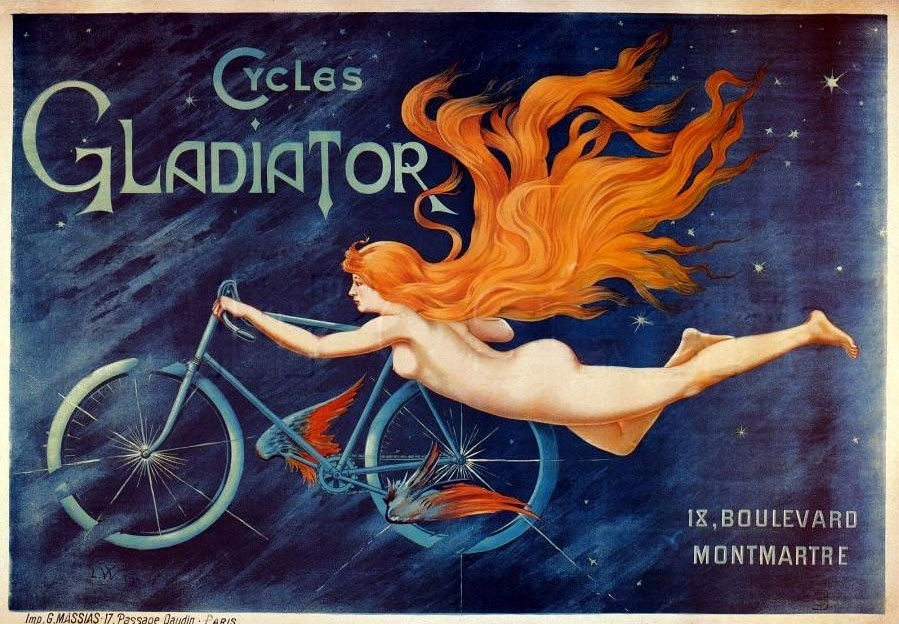
By the 1890s, poster art had widespread usage in other parts of Europe, advertising everything from bicycles to cigarette rolling papers, and bullfights. By the end of the 19th century, during an era known as the Belle Époque, the standing of the poster as a serious art form was raised even further.
Between 1895 and 1900, Jules Chéret created the “Maîtres de l’Affiche” (Masters of the Poster) series that became not only a commercial success, but is now seen as an important historical publication.
The publication consisted of 256 color lithographic plates reproduced from the original works of ninety-seven artists in a smaller 11 x 15 inch format.
The varied selection of prints were sold in packages of four and delivered monthly to subscribers. On sixteen occasions during the selling period between December 1895 through November 1900, the monthly package included a bonus of a specially created lithograph.
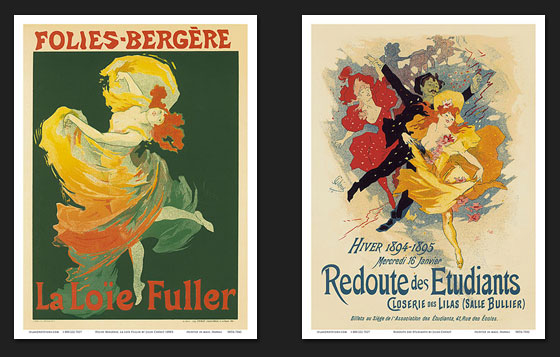
Jules Chéret, “Folies Bergeres” and “Redoute des Etudiants”
Jules Chéret (1836 -1932)

Jules Chéret was a French painter and lithographer who became a master of Belle Époque poster art. He has been called the father of the modern poster. At age thirteen, he began a three-year apprenticeship with a lithographer and then his interest in painting led him to take an art course at the École Nationale de Dessin. Like most other fledgling artists, Chéret studied the techniques of various artists, past and present, by visiting Paris museums. From 1859 to 1866, he was trained in lithography in London, England, where he was strongly influenced by the British approach to poster design and printing.
On returning to France, Chéret created vivid poster ads for the cabarets, music halls, and theaters such as the Eldorado, the Olympia, the Folies Bergère, Théâtre de l’Opéra, the Alcazar d’Été and the Moulin Rouge. He created posters and illustrations for the satirical weekly Le Courrier français.
In 1895, Chéret created the Maîtres de l’Affiche collection, a significant art publication of smaller sized reproductions featuring the best works of ninety-seven Parisian artists. His success inspired an industry that saw the emergence of a new generation of poster designers.

Jules Chéret, “Pantomimes Lumineuses”
To be continued…
Thank you for reading this blog, your feedback is appreciated!
The History of Poster Art over the last two Centuries. Part 1

The modern poster, as we know it, dates back to 1870 when the printing industry perfected color lithography and made mass production possible.
Posters have come to be recognized as a vital art form, attracting artists at every level, from painters to theatrical and commercial designers and they have shown a great range of styles. Posters, in the form of placards and posted bills, have been used since earliest times, primarily for advertising and announcements. Purely textual posters have a long history: they made citizens aware of government or church proclamations for centuries.

Martin Luther nails his reformist theses at All Saints Church in Wittenberg, Germany, 1517
However, the great revolution in posters was the development of printing techniques that allowed for cheap mass production and printing, including notably the lithographic technique which was invented in 1796 by the German Alois Senefelder. The invention of lithography was soon followed by chromolithography, which allowed for mass editions of posters illustrated in vibrant colors to be printed.
By the 1890s, the technique had spread throughout Europe. A number of noted French artists created poster during this period. Jules Chéret is considered to be the “father” of advertisement placards. He was a pencil artist and a scene decorator, who founded a small lithography office in Paris in 1866. He used striking characters, contrast and bright colours, and created over 1000 advertisements, primarily for exhibitions, theatres, and products. The industry soon attracted the service of many aspiring painters who needed a source of revenue to support themselves.

Chéret developed a new lithographic technique that suited better the needs of advertisers: he added a lot more color which, in conjunction with innovative typography, rendered the poster much more expressive. Not surprisingly, Chéret is said to have introduced sex in advertising or, at least, to have exploited the feminine image as an advertising ploy. In contrast with those previously painted by Toulouse-Lautrec, Chéret’s laughing and provocative feminine figures meant a new conception of art as being of service to advertising.
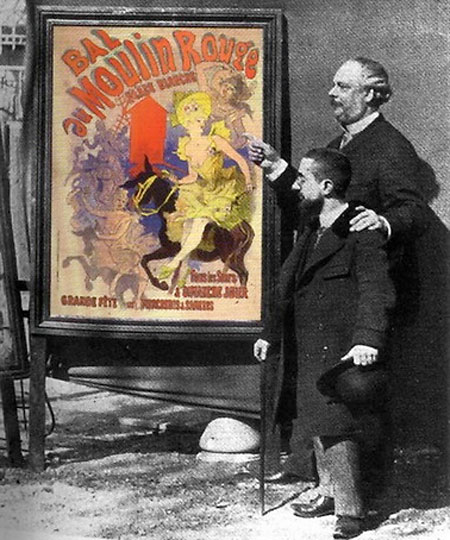
Jules Chéret and Toulouse- Lautrec (with cane), ca. 1894
Posters soon transformed the thoroughfares of Paris into the “art galleries of the street.” Their commercial success was such that some of the artists were in great demand and theatre stars personally selected their own favorite artist to do the poster for an upcoming performance. The popularity of poster art was such that in 1884 a major exhibition was held in Paris.
To be continued…